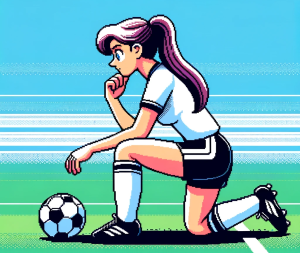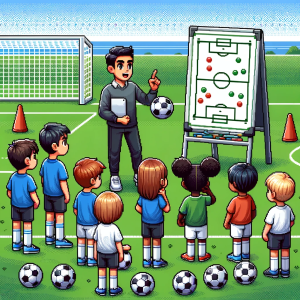
How Simple Cues Shape Young Soccer Players’ Kicks
Every coach has yelled it: “Keep your eye on the ball!” But what if that classic advice is actually hurting performance—especially for young players?
A new study in Scientific Reports by Golnoosh Abdi and colleagues (2025) tackled this age-old question head-on. Researchers worked with 112 girls aged 10–12, none of whom played organized soccer, to explore how attentional focus—what players think about while performing a skill—affects their ability to strike accurately.
Their experiment compared four groups:
- External focus: concentrate on the ball being kicked.
- Internal focus: concentrate on the part of the foot doing the kicking.
- Holistic focus: focus on the overall feel of a solid kick.
- Control: no specific focus.
The players performed 40 kicks each—first at a stationary ball, then a rolling one. The results flip conventional wisdom on its head.
What the Science Says
When the task was easy—kicking a stationary ball—players who focused externally (on the ball) or holistically (on the feeling of a clean strike) outperformed those focusing internally or given no direction.
But when the task got harder—kicking a rolling ball—the story changed. Only the holistic focus group maintained their accuracy. Players told to think about the ball or their foot lost precision.
In other words, as task difficulty rose, only those paying attention to the feeling of the movement stayed consistent.
That insight is gold for coaches working with young or novice players. It suggests that how you cue players can either free their movements or tie them in knots.
Why It Works: Less Thinking, More Flow
This ties back to what sport scientists call the Constrained Action Hypothesis: when athletes overthink technique (“lock your ankle,” “turn your hip”), they interrupt their body’s natural coordination.
A holistic or external focus allows movements to run more automatically—what players might describe as being “in the zone.”
- External focus directs attention toward the goal—for instance, where the ball should go.
- Holistic focus centers on the feeling of the movement—fluid, balanced, and powerful.
- Internal focus, by contrast, makes players micromanage body parts, leading to stiffness or timing errors.
For simple drills, external focus is plenty. But as coordination demands rise—timing a run-up, connecting with a moving ball—a more holistic approach seems to keep players fluid and confident.
4 Takeaways for Coaches and Trainers
- Change your language.
Swap “lock your ankle” for “feel the snap of contact.” Cue sensations and outcomes, not body parts. - Match the cue to the challenge.
- For easy drills (passing a still ball), use external focus: “Aim for the corner.”
- For complex drills (moving balls, volleys, combination plays), use holistic focus: “Feel the rhythm,” “Smooth and solid.”
- Avoid overcorrection.
When players struggle, resist giving mechanical feedback mid-drill. Instead, ask what felt right about their best attempt. - Use attentional variety in training plans.
Mix focus types intentionally—external for target accuracy, holistic for game flow—to build flexible performers who adapt under pressure.
Bigger Picture: Rethinking Player Development
This study also underscores something deeper: context matters.
The participants were young girls with no formal soccer experience—players often overlooked or under-coached due to lingering gender stereotypes in sport. Yet, they showed remarkable improvement when given cues that reduced pressure and promoted confidence.
That finding should encourage youth clubs to prioritize psychological comfort and autonomy as much as biomechanics. Teaching girls to trust how the game feels, not just how it looks, could be key to retention and long-term growth in female soccer programs.
Your Turn to Kick It Off
This research challenges us to coach with both science and empathy.
Next time your team lines up for finishing drills, try experimenting:
- What happens when you stop giving “mechanical” feedback and start emphasizing feel?
- How do your players respond when focus cues match the difficulty of the task?
- Could attentional focus training become part of your club’s player development philosophy?
Small tweaks in how we talk about focus can unlock big gains in performance and confidence—especially for the next generation of players learning to love the game.


